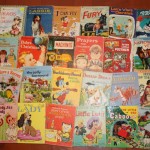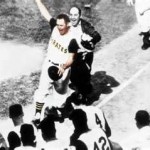 I love reading, listening to and telling stories; I always have. I think we all do. From the time I was a small child I loved hearing bedtime stories. Even before I understood the symbols on the pages as letters of the alphabet, I tried to link together the drawings and pictures in my Little Golden Books into some kind of meaningful story. Even before I could recognize sequences of letters as words, and sequences of words as sentences, and sequences of sentences as paragraphs, my childlike mind strung the ideas together into a sort of narrative stream that allowed me to make sense of what was printed on the pages of those books.
I love reading, listening to and telling stories; I always have. I think we all do. From the time I was a small child I loved hearing bedtime stories. Even before I understood the symbols on the pages as letters of the alphabet, I tried to link together the drawings and pictures in my Little Golden Books into some kind of meaningful story. Even before I could recognize sequences of letters as words, and sequences of words as sentences, and sequences of sentences as paragraphs, my childlike mind strung the ideas together into a sort of narrative stream that allowed me to make sense of what was printed on the pages of those books.
Of course, all of the stories that I loved so much weren’t confined to books. I loved the stories that my parents, my aunts and uncles, my brothers, and my friends would tell; stories about their lives, about their experiences, and about worlds they only imagined. When my own daughters were small, they loved to have me tell them bedtime stories, about characters I invented and they crazy things those characters did.
stories that I loved so much weren’t confined to books. I loved the stories that my parents, my aunts and uncles, my brothers, and my friends would tell; stories about their lives, about their experiences, and about worlds they only imagined. When my own daughters were small, they loved to have me tell them bedtime stories, about characters I invented and they crazy things those characters did.
Much later in my life I came to understand a lot more about the power of narrative, and the value of being able to tell a good story. During my working years at Prudential, most of my jobs were in the financial realm–a world that most people perceive as numbers oriented. But, for me, the fun part wasn’t merely accumulating the data and assembling the numbers into some kind of report. It was never about the balance sheets and income statements and cash flow statements; it was about uncovering the story behind what was shown on those financial statements. What I brought to the table wasn’t my ability to compile numerical data, it was the gift to be able to translate numbers on a page into a compelling narrative, a story that helped people make sense of their business world, as represented by those numbers.
I also learned how stories help leaders connect with the people in their organizations. Whenever I had the opportunity to speak to groups of people in our company, I tried to tell them stories that would make it easy for them to construct a personal connection to what we were trying to do as a company.
I still remember getting up on a stage in front of hundreds of people at a Prudential Real Estate & Relocation Services meeting and asking those who were old enough if they remembered what they were doing when Pittsburgh Pirate second baseman Bill Mazeroski’s hit the 9th inning walk-off home-run in Game 7 of the 1960 World Series to beat the Yankees. I did. I was sitting in Miss Powers’ 7th grade classroom at St. Therese School, listening to her transistor radio, along with my classmates. And I remember Margaret Stanichar’s rosary beads flying into the air as Bob Prince, the KDKA radio announcer called the play.
still remember getting up on a stage in front of hundreds of people at a Prudential Real Estate & Relocation Services meeting and asking those who were old enough if they remembered what they were doing when Pittsburgh Pirate second baseman Bill Mazeroski’s hit the 9th inning walk-off home-run in Game 7 of the 1960 World Series to beat the Yankees. I did. I was sitting in Miss Powers’ 7th grade classroom at St. Therese School, listening to her transistor radio, along with my classmates. And I remember Margaret Stanichar’s rosary beads flying into the air as Bob Prince, the KDKA radio announcer called the play.
 Then I asked them if they remembered what they were doing when astronaut John Glenn took his first step from the Lunar Lander onto the surface of the moon. I did. I was with my family on a Sunday afternoon, surrounding the TV as Walter Cronkite told America what was going on as we all watched the video feed from NASA.
Then I asked them if they remembered what they were doing when astronaut John Glenn took his first step from the Lunar Lander onto the surface of the moon. I did. I was with my family on a Sunday afternoon, surrounding the TV as Walter Cronkite told America what was going on as we all watched the video feed from NASA.
 Finally, I asked them how clearly they remembered where they were and what they were doing during the horrific events at the World Trade Center on 9-11. I related that I was with my wife and some friends in the small town of Monterosso al Mare in the Cinque Terre region of Italy, desperately trying to find out what was going on, fearful about our daughters, one of whom was in New York City that week, the other living in Washington, DC.
Finally, I asked them how clearly they remembered where they were and what they were doing during the horrific events at the World Trade Center on 9-11. I related that I was with my wife and some friends in the small town of Monterosso al Mare in the Cinque Terre region of Italy, desperately trying to find out what was going on, fearful about our daughters, one of whom was in New York City that week, the other living in Washington, DC.
Then I shared some research into brain activity that indicated that the brain centers that deal with strong emotions are located right next to the parts of the brain associated with long-term memory, drawing the stories together into a narrative arc that connected emotionally charged experiences with memory imprinting, then wrapping it up by showing that their work had great power to build good memories for our customers. It seemed like a much better approach than simply exhorting them to work harder and generate higher profits. The people in that audience really seemed to make a personal connection through those stories to a new way of thinking about their work. Their job was making great memories for our customers.
There is some interesting science that helps explain the extraordinary power of narrative. I’ll delve into that science in the next edition of this blog: Stories, Part 2: Telling Stories